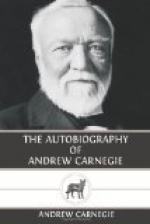Another curious fact has recently been discovered. Mr. John Morley’s address, in 1904 on Founder’s Day at the Carnegie Institute, Pittsburgh, referred to the capture of Fort Duquesne by General Forbes and his writing Prime Minister Pitt that he had rechristened it “Pittsburgh” for him. This General Forbes was then Laird of Pittencrieff and was born in the Glen which I purchased in 1902 and presented to Dunfermline for a public park. So that two Dunfermline men have been Lairds of Pittencrieff whose chief work was in Pittsburgh. One named Pittsburgh and the other labored for its development.
In naming the steel mills as we did the desire was to honor my friend Edgar Thomson, but when I asked permission to use his name his reply was significant. He said that as far as American steel rails were concerned, he did not feel that he wished to connect his name with them, for they had proved to be far from creditable. Uncertainty was, of course, inseparable from the experimental stage; but, when I assured him that it was now possible to make steel rails in America as good in every particular as the foreign article, and that we intended to obtain for our rails the reputation enjoyed by the Keystone bridges and the Kloman axles, he consented.
He was very anxious to have us purchase land upon the Pennsylvania Railroad, as his first thought was always for that company. This would have given the Pennsylvania a monopoly of our traffic. When he visited Pittsburgh a few months later and Mr. Robert Pitcairn, my successor as superintendent of the Pittsburgh Division of the Pennsylvania, pointed out to him the situation of the new works at Braddock’s Station, which gave us not only a connection with his own line, but also with the rival Baltimore and Ohio line, and with a rival in one respect greater than either—the Ohio River—he said, with a twinkle of his eye to Robert, as Robert told me:
“Andy should have located his works a few miles farther east.” But Mr. Thomson knew the good and sufficient reasons which determined the selection of the unrivaled site.
The works were well advanced when the financial panic of September, 1873, came upon us. I then entered upon the most anxious period of my business life. All was going well when one morning in our summer cottage, in the Allegheny Mountains at Cresson, a telegram came announcing the failure of Jay Cooke & Co. Almost every hour after brought news of some fresh disaster. House after house failed. The question every morning was which would go next. Every failure depleted the resources of other concerns. Loss after loss ensued, until a total paralysis of business set in. Every weak spot was discovered and houses that otherwise would have been strong were borne down largely because our country lacked a proper banking system.




